NVIDIA’s GeForce GTX 460: The $200 King
by Ryan Smith on July 11, 2010 11:54 PM EST- Posted in
- GPUs
- GeForce GTX 400
- GeForce GTX 460
- NVIDIA
Power, Temperature, & Noise
As we’ve discussed in previous articles, with the Fermi family GPUs no longer are binned for operation at a single voltage, rather they’re assigned whatever level of voltage is required for them to operate at the desired clockspeeds. As a result any two otherwise identical cards can have a different core voltage, which muddies the situation some. All of our GTX 460 cards have an idle voltage of 0.875v, while their load voltage is listed below.
| GeForce GTX 460 Load Voltage | |||||
| Ref 768MB | Ref 1GB | EVGA 768MB #1 | EVGA 768MB #2 | Asus 768MB | Zotac 1GB |
|
0.987v
|
1.025v
|
0.987v
|
1.000v
|
0.987v
|
1.000v
|
Our cards end up ranging from 0.975v to 1.025v, a variance of 0.05v. The 1GB cards with additional functional units on average require more voltage to operate, with the lowest of our samples requiring 1.0v. Otherwise 3 of our 4 768MB cards require 0.975v.
On a side note, since we’re using non-matching 1GB GTX 460s here for SLI testing, we’ve added an asterisk for all the power & temperature results. Our results should be very close to what a proper set of matching reference cards would get, but we can’t guarantee that.
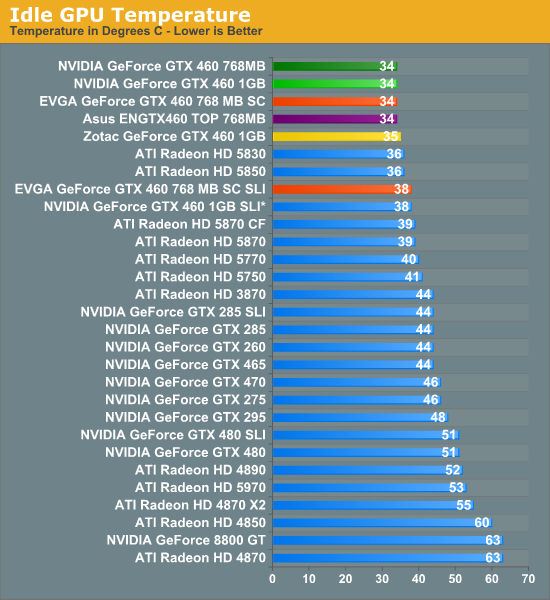
We’ll start with idle temperatures. With an unofficial idle TDP in the 20W range, the GTX 460 series is fairly comparable to the Radeon 5850, but with a more breezy cooler. As a consequence we can see it edge out the rest of our cards here, with all of the open GTX 460s coming in at 34C for idle. Meanwhile the blower-based Zotac card comes in a hair warmer at 35C. Even with a blower, these end up being the coolest mid-range or better cards we have ever tested, besting even the Radeon 5850.
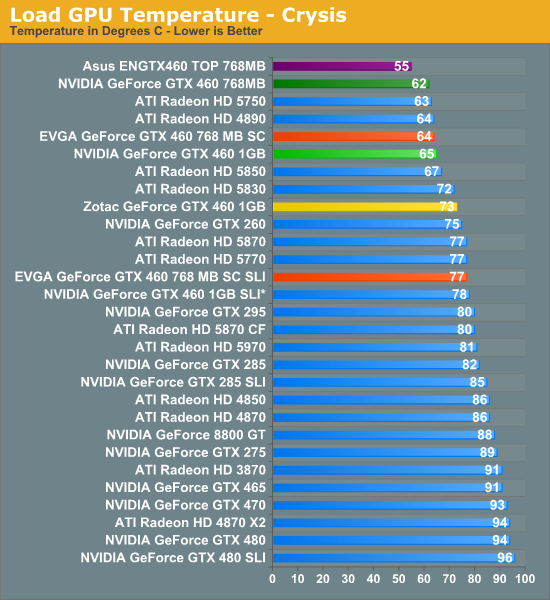
Meanwhile at load the good news continues for the GTX 460 series. The GTX 480 may have been a toasty GPU, but that’s not the case for the GF104 GPU at the heart of the GTX 460 series. Our reference cards do only slightly worse than 60C in Crysis, while Asus’s non-reference card gets that even lower thanks to a more proactive fan. Zotac’s blower doesn’t fare so well here though, coming in at a still respectable but nevertheless higher 73C.
Compared to AMD’s cards the GTX 460 does very well here. The Radeon 5850 is still the sweet spot for a balance of performance and heat, but the GTX 460 manages to do better in terms of heat at a price of lower gaming performance. Meanwhile our Radeon 5830 isn’t even a contender here; as a salvaged Cypress part, it just can’t compete with a part designed for cooler performance from the start. Among all the cards we’ve tested equal to or faster than the 8800GT however, the GTX 460 sets the new bar for how cool a high performance card can operate.

The results with Furmark match those of Crysis, it’s just a bit hotter. The interesting story here is going to be SLI temperatures: our 768MB and 1GB SLI cards hit 89C and 91C respectively. This isn’t a problem for NVIDIA’s GPUs (we see single GTX 480 cards do worse) but it’s a massive jump from a single card. For these reasons we would strongly suggest keeping these cards further spaced apart if you have a motherboard that supports it. The GTX 460 reference cooler just isn’t up to the task of pulling in fresh air if it’s next to another card.
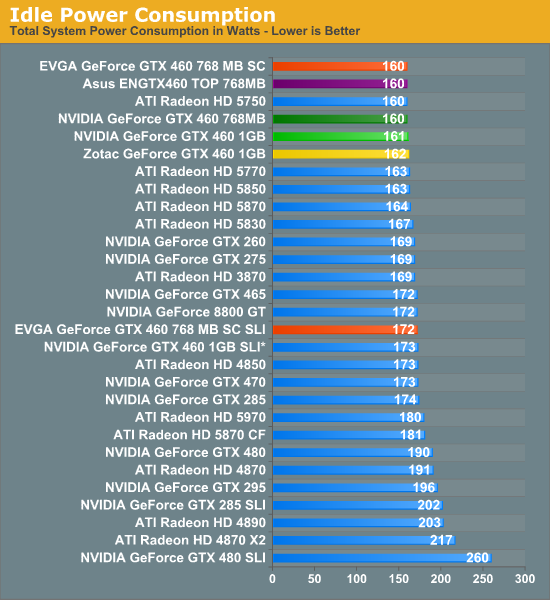
Our idle power numbers continue to lower the bar for GPUs of this performance class, although at this point we’re hitting the efficiency limits of our PSU at low wattages. Our 768MB GTX 460s end up sharing the 160W mark with the Radeon HD 5750, while for 1W more you have the 1GB cards.
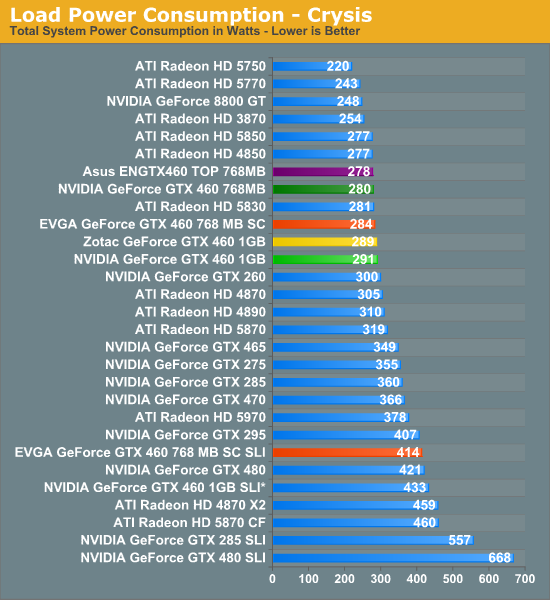
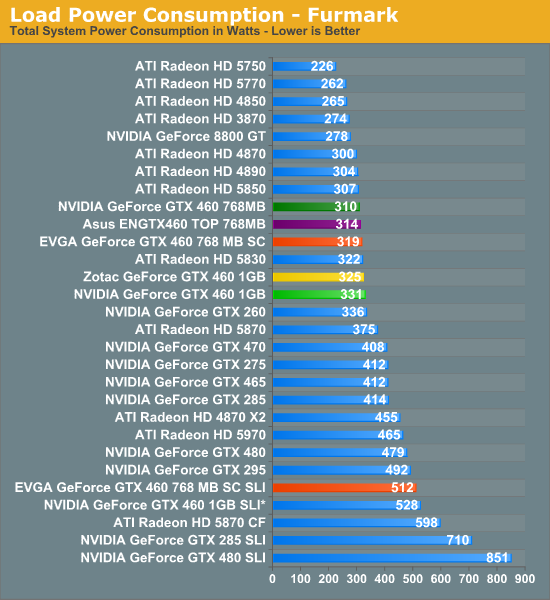
When looking at load power consumption, it’s always interesting to compare the power drawn with the temperatures. While the GTX 460 did very well here with regard to temperature, its power consumption reflects the fact that its GPU is still Cypress-sized. Under Crysis at a 280W load the 768MB part is comparable to the Radeon 5830 and the 1GB part adds around 10W to that. Meanwhile the Radeon 5850 manages to pull just a bit less power here, while the GTX 465 draws some 60W-70W more than the GTX 460. Gmae performance with those two cards may be close – power consumption is not.
As for Furmark the power consumption goes up but the ordering does not. Our 1GB cards now draw 20W more than 768MB cards, but the Radeon 5830 is still in the middle of the pack while the Radeon 5850 comes out ahead. The GTX 465 is now 80W-100W hotter than the GTX 460. Overall with a “proper” Radeon 5000 series card NVIDIA still can’t match AMD on a performance per watt basis, but they can come very close.
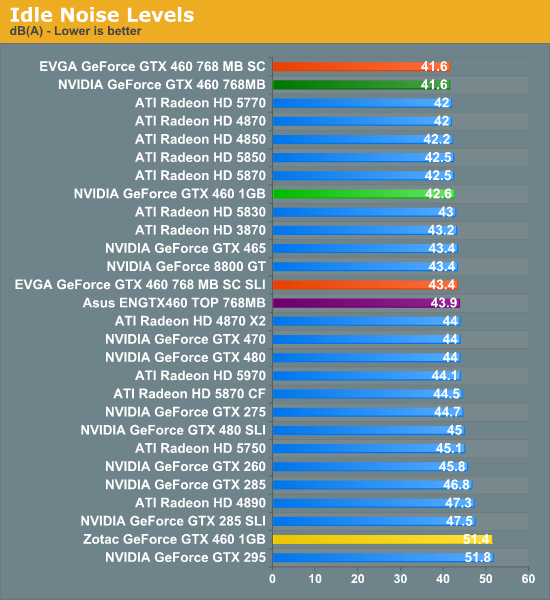
Finally we have our look at noise. With cool running cards we often have to look at fan noise to ensure that they aren’t accomplishing that trick by sounding like a jet engine, and in the case of the GTX 460 that’s clearly not the case. Besides being some of the coolest cards we’ve tested at this performance level the GTX 460 cards are also just as quiet as the rest of the best of the cards we’ve tested, hugging the 42dB sound floor in our testing environment. The 1GB reference card is marginally louder, while the partner customized cards are only slightly louder yet. The only card to really flop here is the Zotac GTX 460, which is at entirely the wrong end of our charts. Blowers can be quiet, but the Zotac’s is not – it’s simply a loud card. Unfortunately this kind of an idle noise level is going to put the card out of the running for a lot of buyers.
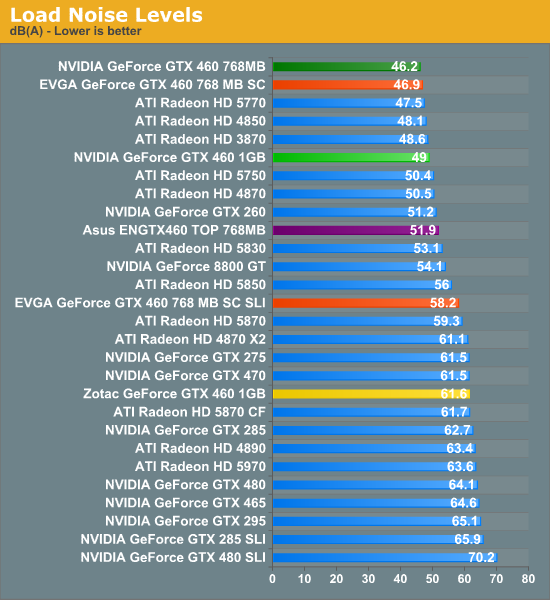
Load noise is more or less like our idle noise results. The 768MB GTX 460 registers the lowest result we’ve ever seen for a card of this performance level, coming in at 46.2dB and the EVGA card right behind it. The 1GB card does end up being louder (likely to compensate for cooling 2 more GDDR5 chips) but it’s still in good company. Asus’s card cracks 50dB, as it’s tuned for cooling over noise, explaining our earlier temperature results. Unfortunately the Zotac card is once again the odd man out at 61dB, roughly as loud as our GTX 470 is. It’s neither cooler than our reference cards nor quieter, which doesn’t bode well for this stock-clocked card.










93 Comments
View All Comments
medi01 - Tuesday, July 13, 2010 - link
It was like that some day. But now I see more and more troubling signs. iPhone dissapearing from comparison photos ("oh, I've forgotten, it should have been in my pocket") when it has huge disadvantage, but always shown where it has advantage. (and happy readers crowd not "noticing" such "unimportant detail")AMD's 5830, the 200$ card with the same "it's slower than older... but it has some features" got serious beating right in the title. (guess what, it was actually cooler than older cards, so it had one advantage more than that of nVidia). On the other hand nVidia's 200$ card that is EXACTLY in the same positoin, got PRAISED in the title.
How on earth could that be called neutral?
ViRGE - Tuesday, July 13, 2010 - link
The 5830 launched at $240, not $200. In that respect the GTX 460 is not only launching at that cheaper price, but it's faster than the 5830 (and the 4890 the 5830 failed to beat).maxpain12 - Friday, September 17, 2010 - link
I agree with Lonyo, they are simply pointing out the technical aspects of the silicon. It gives those that follow the latest and greatest developments in chip architecture some food for thought. It was never intended to mislead a customer, the performance numbers are enough evidence to give the customer a decent understanding of what to expect in the real world application of the chip in consideration.Quidam67 - Saturday, July 17, 2010 - link
You're being a bit a of a fan-boy in my opinion. The article is very well balanced. Seriously, the 460 is the first good card from nVidia in a long time, and at a genuinely afordable price. ATI finally have some real competition on their hands. Up till now they have owned this generation. And the 5830 was always an odd fit for that market sector. Really, it was just an afterthought on how to repurpose 5870 rejects. It filled a hole, but now that hole doesn't exist anymore. It's the one ATI card from this generation that I really didn't like.Zendax - Saturday, July 31, 2010 - link
When the 5830 was released there was no current generation competition, so the only point of comparison was the past generation of cards.With the 465 the obvious points of comparison are the 5830 and 5850.
I'm not going to say, resolutely, that there's zero bias, but you're clearly LOOKING for an nVidia bias, and when you go about it that way, you're guaranteed to find it.
Goty - Monday, July 12, 2010 - link
... meh.It's a decent card, but it's still months too late.
notext - Monday, July 12, 2010 - link
I agree. It is good but AMD could easily drop the 5850 down to the 1gb prices and the advantage is gone. Hopefully they will.Quidam67 - Saturday, July 17, 2010 - link
That's what I hope will happen, because at the moment my next card is going to be a GTX 460 unless the 5850 price drops a littleDominionSeraph - Monday, July 12, 2010 - link
Not all of us scour rumor sites and wait with bated breath for months for the next big thing to come out. For some of us, waiting a few months is no big deal. (especially with the lack of any "must-have" gaming titles. The heyday of PC gaming is long over.)Since the launch-price 5850's (which didn't last long), the GTX 460 seems to be the first really good buy out there. The 5770 didn't outperform the 4870, the 5830 was an overpriced turd, the price-gouged 5850's and 5870's aren't good price/performance bargains, the GTX 470 and 480 are no better and are power hogs to boot.
THIS has me excited -- especially the SLI scaling. $400-$460 in cards that'll often beat a $700 5970? And they have low idle power consumption and decent load consumption (for the performance)? I mean in that price range is the 5870, GTX 480, and 4870 x2, and GTX 460 SLI beats them all. The 5870 has much lower load power consumption going for it but it's also significantly slower.
Unless you're going to need the power of 5870 in CF, the GTX 460 seems to be the way to go.
Rekdurexu - Monday, July 12, 2010 - link
"For everything but the high-end, this year is a feature yet and not a performance year."Is that "yet" supposed to be year?